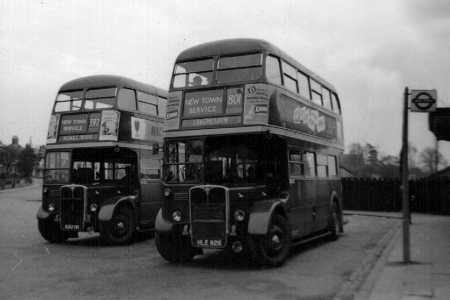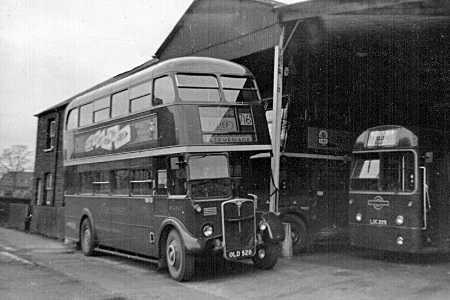London Transport
1953 (registration date)
AEC Regent III RT – RT8/2
Weymann H30/26R
Two weeks ago my contribution for the ex London Transport STL2117 was posted on this site, the shot was taken in April 1958. At about the same time that shot was taken, spiffing new RTs were coming on stream, and here is a shot of KGU 191 RT2262 and new NLE 826 RT3719 at the old Stevenage railway station route terminus. Would I be right is saying that NLE 826 RT3719 was one of many stored new at Loughton garage for ages, awaiting entry to service as NLE was 03/53 – 11/53, presumably because RT production had exceeded requirement?
Or was OLD 528 RT4742 one of those last entrants to the fleet? (In Green Line rig, unusually……) Seen according to my notes at Hitchin along with AEC Regal IV LUC 225 RF25 which was last in the first batch of 25 Regals delivered at the 27ft 6in length and were classed as Private Hire Coaches for sightseeing tours and the like. In the mid 50s ten of the batch 16-25 were transferred to Green Line. Unfortunately the glazed sightseeing roof panels can not be seen in this shot.
Photographs and Copy contributed by Victor Brumby
27/01/12 – 17:37
According to the vehicle histories on “Ian’s Bus Stop” website, RT 3719 entered service at Windsor (WR) garage in May 1953, and transferred to Hitchin garage in 1957. (//www.countrybus.org/)
His histories haven’t got as far as the 47xx sequence, but RT 4742 was (according to Ken Glazier’s “London Buses in the 1950s”) one of those delivered straight to storage in 1954 and entering service between March 1958 and August 1959. Ken Blacker’s definitive work on the RT class lists dates of entry to service, but I do not have a copy to hand.
The appearance of (bus livery) RTs on Green Line coach services was not that uncommon – many routes at that time had one or two peak hour duplicates, and most routes required relief buses particularly on summer Sundays – to cater for Londoners visiting the countryside, and (where routes served new towns such as Stevenage) visits between new town residents and their friends and relatives still living in inner London.
The provision of a few RTs in semi Green Line livery (green central band, Green Line transfers between decks) at country bus garages to cater for this happened in 1960 (again, according to Ken Glazier’s book.)
There is more about Hitchin garage (closed 1959) here – //www.ampyx.org.uk/ – the building is still standing, although I understand there is a current planning application in which will involve demolition.
Jon
29/01/12 – 07:32
According to Ken Blacker’s RT book, RT4742 (OLD 528) was indeed one of those stored for the first few years of its life, finally entering service in March 1958, at SV (Stevenage, Fishers Green).
Bob Gell
27/08/12 – 07:58
Firstly can I say how pleased I was to see the photo of the RT’s at the old Stevenage Station, I can only just remember this Station, I was five when it moved, and new ‘AN’s were coming on stream. The other photograph of the Green Line RT is a real gem, as it is the only photograph I have seen, besides one in Ken Blackers ‘RT’ book of the first Stevenage depot, situated in a cul-de-sac off Fishers Green Road, behind the old Station which was in use as a temporary outstation of Hitchin & Hatfield until the new depot in Danestrete opened in 1959.
Alec Bright
06/11/12 – 06:46
Just a quick note to confirm that the building shown behind the RT is Stevenage Fisher’s Green, and not Hitchin. You will find a 1990s image of the garage with its curiously pitched and slanting roof span on my web page: //www.ampyx.org.uk/
The story unfolding in Hitchin today is complex, and the local historical society are still trying to persuade the planning authorities of the value of the structure. You may have seen coverage in BUSES an B&CP magazines.
By coincidence, the National (later UCOC) garage in Fishponds Road was demolished in September of this year.
I am shocked at how much revision of my historical pages is necessary. Thank you all for your comments and suggestions.
Jonathan Wilkins


Leave a Reply